-
TrackoBit
Manage commercial vehicles with the new-age Fleet Management Software
TrackoBit -
TrackoField
Streamline your scattered workforce with Field Force Management Software
TrackoField -
Features Resources
-
Blog
Carefully curated articles to update you on industrial trends. -
White Paper
Insightful papers and analysis on essential subject matters. -
Glossary
Explore an alphabetical list of relevant industry terms. -
What’s New
Get TrackoBit & TrackoField monthly updates here. -
Case Study
Explore the cases we solved with our diverse solutions. -
Comparisons
Compare platforms, features, and pricing to find your best fit.
-
About Us
Get to know TrackoBit: our team, ethos, values, and vision. -
Careers
Join the most dynamic cult of coders, creatives and changemakers. -
Tech Support
Learn about our technical support team and services in detail. -
Events
Check out the exhibitions where we left our marks and conquered. -
Contact Us
Connect with us and let us know how we can be of service.
Ultimate Guide to Driving Behavior Monitoring In Your Fleet
- Author:Ayushi Nagalia
- Read Time:14 min
- Published:
- Last Update: December 23, 2025
Table of Contents
Toggle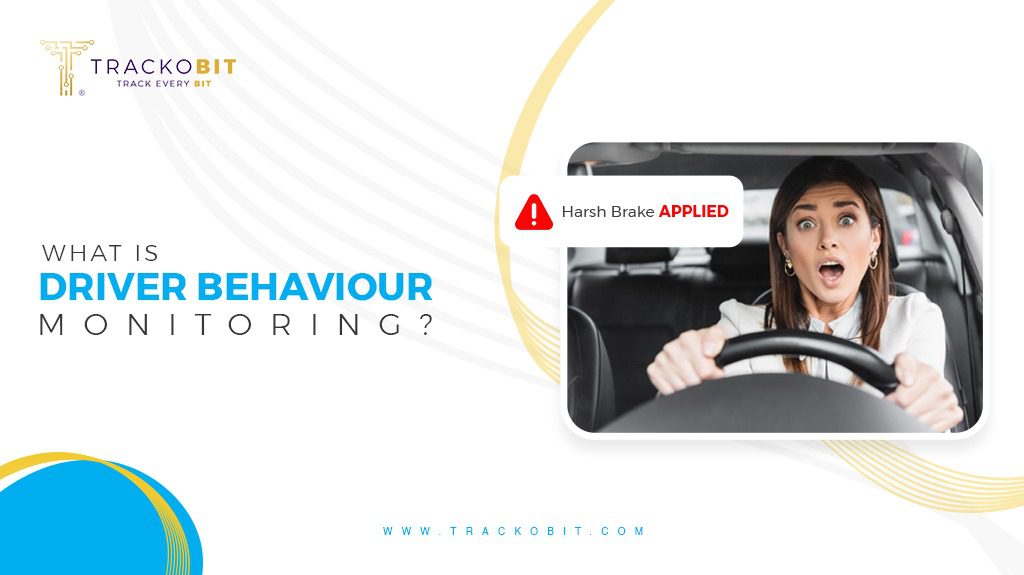
Driver Behaviour Monitoring with Fleet Management Software is a multi-faceted procedure benefitting not just driving, but overall fleet safety, sustainability, and performance!
Table of Contents
Toggle
Imagine you have two identical fleets.
You implement a driver behaviour monitoring system in one and let the other drivers do whatever they want. The difference between the resource consumption of these fleets can be up to 75%. The latter fleet is also 64% more susceptible to being involved in road accidents.
That’s how powerful driver behaviour monitoring solutions can be!
So, do you want to keep an eye on the people supposed to keep an eye on your assets? And do you want to drive your sales and business’ safety to the top? Let us look into how effective driver monitoring and analysis can help you do just that!
How Important is a Driver’s Role in a Fleet?
Who will drive your vehicles if not the drivers? Without drivers, a fleet simply can not exist!
Needless to say, other than vehicles, drivers are the most crucial part of your fleet business model. They don’t just drive your vehicles, but your fleet business in general. After all, they are responsible for
- Consignment reaching the destination on time
- Vehicles staying safe
- Keeping accident cases at bay
- Maintaining healthy engines
- Overall fuel consumption
- Maintaining goodwill by compliance and timely work
- Overall operational execution
- Total fleet productivity
What’s more is that as assets to your business, their safety is also a primary factor of concern for fleets!
Human errors, that drivers are most likely to make, cost about 1.35 million deaths or 86% of all road accidents a year. Good drivers, on the other hand, can help waive insurance costs even if the vehicle was in an accident!
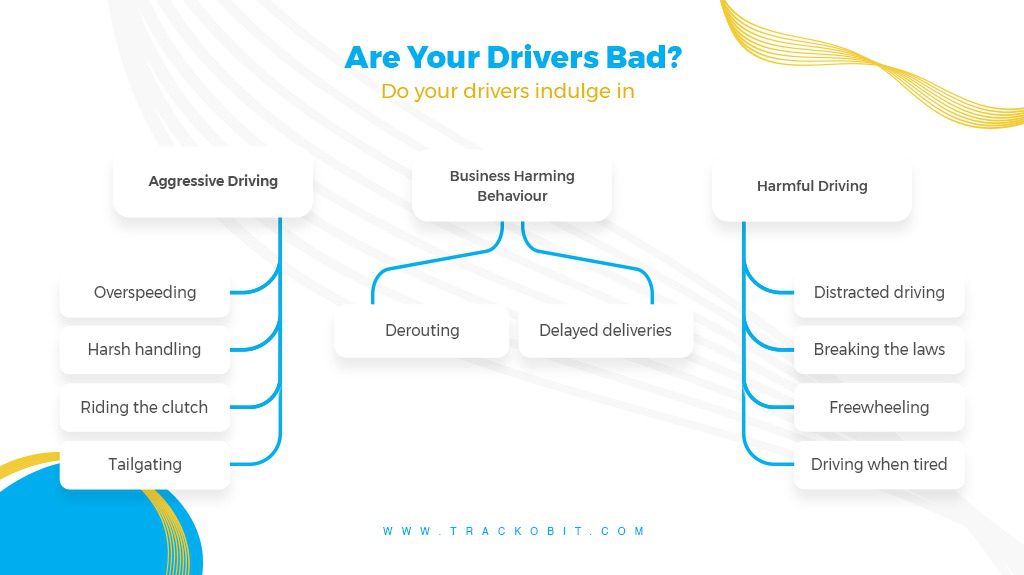
How to Differentiate Between Good and Bad Driving?
Bad driving behaviour is like any generally bad habit humans pick up such as smoking or sleeping in unhealthy positions. Most of the time, we do not even realise when we develop the habit, how it affects our life, and if it is even a problem.
Therefore, it is not the driver’s fault if they have bad driving habits – it is actually natural. However, it is bad when drivers know where they are lacking, and still continue to practice unhealthy driving practices.
But, what are these bad driving practices that you need to be monitoring and eradicating from your fleet? Let’s find out!
Aggressive Driving Skills
- Overspeeding: Overspeeding increases the possibility of an accident by 85% and increases fuel consumption by 20%. Staying within speed limits is crucial for safe and efficient driving.
- Harsh Braking: Each time a driver brakes harshly, they increase fuel consumption by half a gallon. Harsh braking is also not good for your vehicle’s engine and the brake pad, making it depreciate faster.
- Abrupt Acceleration: Bad acceleration practices are as bad as harsh braking. Both of them also decrease road safety.
- Harsh Cornering: Not only can harsh cornering make top-heavy vehicles overturn but also put other closeby vehicles in jeopardy. Harsh cornering is also bad for the vehicle’s tyres.
- Riding the Clutch: While riding the clutch seems innocent, it causes the disc to prematurely wear and fail. If this happens during a trip, it can be dangerous for the vehicle to go further and is also an expensive affair to fix.
- Tailgating: Driving too close to the vehicle in front is dangerous. If the latter brakes abruptly, a rear-end collision will surely cost a lot in repairs and insurance addressal.
Harmful Driver Behaviour
- Smoking: Smoking can temporarily tamper with motor functions, is a fire hazard, and can even be a cause of distraction while driving.
- Distracted Driving: Driving distractedly because of cell phone use leads to 1.6 million crashes each year. Anything that doesn’t need their immediate attention but peels their eyes off the road is not safe.
- Jumping Lights: Failure to follow traffic rules and jumping traffic lights is dangerous since it leads to a lot of accidents and is also a public nuisance.
- Breaking Driving Laws: Not wearing a seat belt and braking other such small traffic rules can lead to heavy fines and worse damage to vehicles, consignments, and drivers in case of an accident.
- Freewheeling: Turning off the engine while going downhill breaks off the power brake and steering functions of the vehicle, putting a heavy vehicle in immense danger.
- Driving Under the Influence: Not only does it increase the chance of accidents but also an overall hazard for business goodwill and consignment safety.
- Driving When Tired: Sleepy driving is sure to lead to accidents and should be avoided at any cost.
Behaviour That Harms Business Operations
- Derouting: Some drivers might use a commercial vehicle for personal use and deroute often for their own purposes. This is essentially chatting the business and exploiting its resources.
- Delayed Driving: Whether it be because of slow driving or taking unnecessary breaks if a driver is constantly late, it breaks the business’ goodwill.
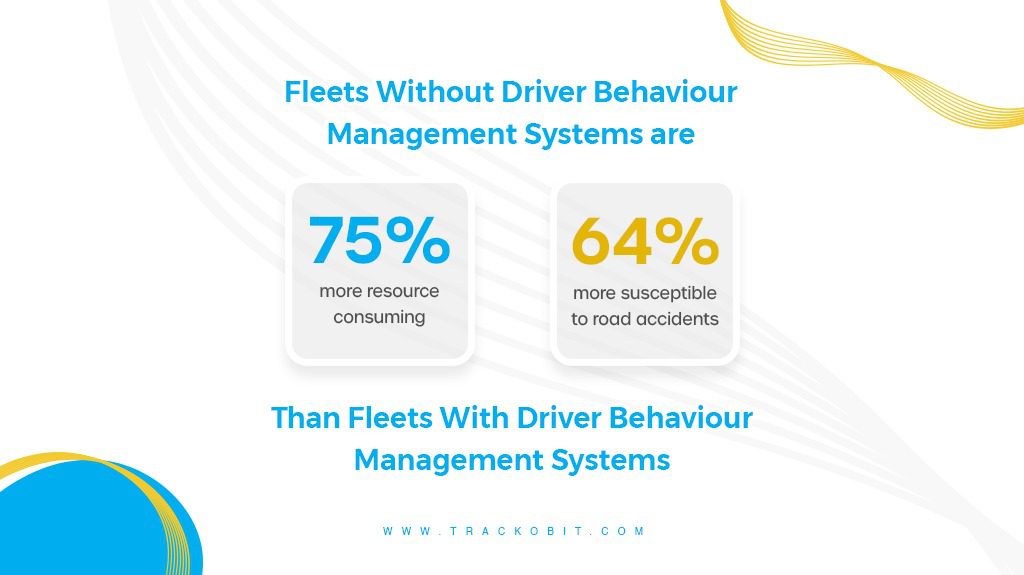
What is Driver Behaviour Monitoring in Fleet Management Systems?
In the olden times, there was no way of tracking driver behaviour. After all, how can fleet owners and managers know what’s happening in the fleet without actually being in the vehicles?
However, in the current times, most fleet management systems come integrated with driver behaviour monitoring systems. Through these systems, supervisors can understand what exactly it is that goes on in their vehicles.
Fleet management systems are essentially data banks for the fleets that are integrated with them. Therefore, it leverages all the sensor, travel, and other information collected throughout each trip to understand how each driver is performing and presents it in digestible reports.
Driver behaviour management systems can also send alerts to managers in case of any unwanted event. Therefore, be it digital or visual, driver behaviour monitoring systems are the ideal way to know how each driver is performing and how each vehicle is driven. After all, driving is the key link between your two most important assets – vehicle and drivers, right?
The Role That Fleet Management Solutions Play in Driver Behaviour Management
If you are using a fleet management solution that has driver behaviour monitoring solutions, you’ll always have data related to how your fleet is driven. However, in the world of dwindling attention spans, you wouldn’t want to be bombarded by a huge number of .txt files that you can hardly sit through, right?
Well, you’ve paid to get better services! Fleet management software uses the following ways to detect, depict, and deduce instances of bad driver behaviour:
- Real-time Visibility: Through live vehicle tracking, you’ll be aware of the drivers’ activities in real time as and when they’re behind the wheel. This way, even if you have switched off driver behaviour anomaly alerts, you can hop on the software to see what everyone is up to. You can also increase visibility through video telematics (but more on that later)!
- Instant Violation Alerts: Every time a driver indulges in bad behaviour and violates the pre-defined norms, the system will trigger alerts to supervisors. This way, managers get to respond, not react to a situation that has already gone uncontrollably bad. Alerts also add a dimension of continuous and effortless supervision to your fleet.
- Detailed Reports: With a cloud-based system, you get the most minute reports that you could ask for. After all, they’re arranging and organising those huge files into bite-sized bits, right? You can get reports for overspeeding, field consumption, and other metrics vehicle-wise, driver-wise, or even trip-wise for a span of 90 days! From speeding reports to stoppage summaries, you get it all!
- Analytical Dashboard: A fleet management system’s analytical dashboard can be viewed according to drivers. Therefore, you can see who the top-performing drivers are and how they are showing improvement over the months. The dashboard offers the best perspective to on-point data insights.
- Driver Scorecard: Fleet management systems can form digital scorecards that allow managers to see which drivers they can trust their high-ticket vehicles and consignment with. By analysing various factors, you get a score rating between zero and five that can further identify good drivers from bad.
How Can GPS Vehicle Tracking Improve Driver Behaviour?
GPS vehicle tracking systems can offer you insights and reports that help. However, it is what happens with those reports that improve driver behaviour in your fleet. Here are a couple of things that happen within your fleet because of driver behaviour monitoring systems that improve how your fleet is driven in the long run.
- Accountability: When drivers are aware that they are under surveillance and their performance is being tracked, they feel accountable. After all, who would want their work to be scrutinized with evidence? Therefore, most drivers start practising healthy driving by themselves.
- Competitiveness: The driver score function of fleet management systems is a sustainable way to increase productivity in the fleet. The drivers who really care about their work (and these are the pens you want to begin with) will want their performance to stand out, encouraging them to be better!
- Better Training: When you see the driver-wise performance, you instantly know where each driver needs improvement. Therefore, instead of imparting vague and general feedback and training, you can really help them with the right inputs from your end.
Testing If Your Drivers Are Sustainable:
Eco-Driving
Eco-driving is the new buzzword in the fleet management industry and for good reason! It is a culmination of a set of driving practices that your drivers should follow to ensure the least possible carbon emission from your vehicles.
Eco-driving practices are known to reduce your fleet’s carbon footprint by 50% while also reducing field consumption and costs.
If you are worried about the amount of fuel your vehicles are consuming and your business’ contribution to global pollution, you must mandate eco-driving practices.
Factors such as route optimization, vehicle maintenance, and maintaining optimum vehicle load are on you. However, you need to ensure that your drivers are not slamming the brake and accelerator, maintain eco-friendly speed, avoid idling, and drive the vehicle in the right gear. Drivers could also ensure that they keep the vehicle rolling as much as they can since constant starting and stopping of the vehicle also consumed too much fuel.
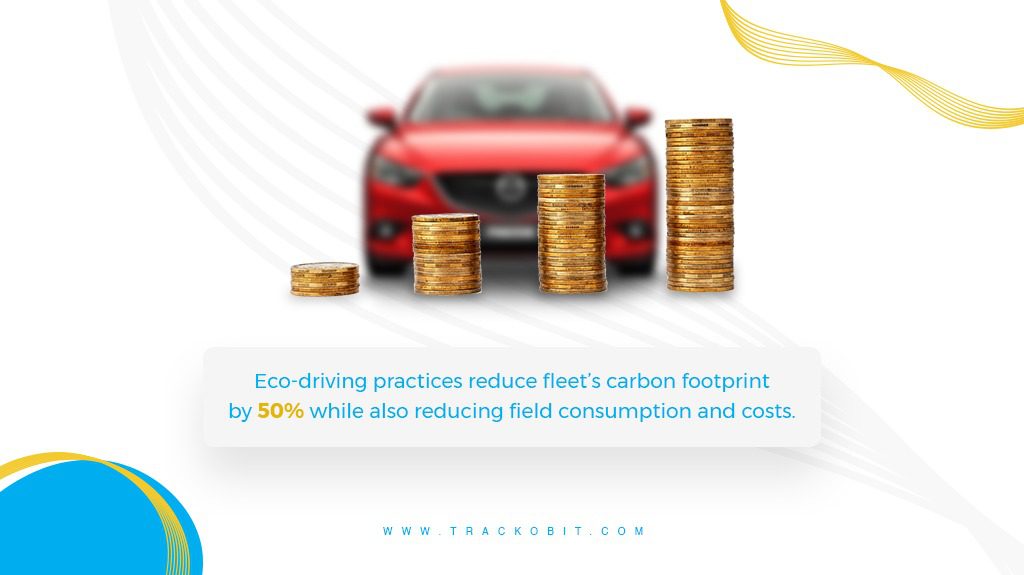
Video Telematics Brings a New Wave to Driver Supervision
Real-time textual visibility is great but is it as good as seeing what is going on in the fleet? Adding another angle of visibility for drivers is a great way to supervise in silence, and that is exactly what video telematics does.
Video telematics is installing cameras inside and outside your vehicle to help managers be omniscient with their fleet. Apart from that, it also makes advanced functions such as proximity sensing, driver safety cautions, and even crash supervision possible.
Video telematics is a new wave of driver supervision because it:
- Allows managers have live visual updates on the drivers’ activities
- Integrated with AI and ML to help build better safety measures for assets
- Provides evidential reports on what is going on in the fleet
- Builds higher accountability in the driving force
- Makes the overall fleet much more robust
- Develops a real time connection between the drivers and the manager
- Offers evidential content for directed feedback
- Prevents the risk of undetected unsafe driving behaviour
- Helps understand the cause of driver fatigue
Sure, being able to visually monitor your fleet is amazing. However, the biggest reason why it is so important for driver supervision is that it enables ADAS and DMS systems.
DMS and ADAS are two crucial features promoting driver supervision and safety. Together, DMS and ADAS offer an extra set of eyes to either the drivers or the managers. Therefore, they don’t just improve fleet management but also the holistic driving experience. How? Let’s see!
Driver Management System (DMS)
DMS is the system that offers managers to look at their drivers more closely. Driver monitoring systems leverage the internal-facing dashcams placed in the vehicle that constantly monitors the drivers’ activities.
The dashcams are integrated with Artificial intelligence. Therefore, if there is any anomaly in the driver’s conduct or activities, the DMS system sends alerts to managers and keeps them posted.
Some of these monitored driver activities are:
- Smoking
- Distracted driving
- Drowsiness
- Yawning
- Absence
With these alerts, management can build a safer fleet for drivers by
- Avoiding distraction
- Sending SOS alarms to drivers if they’re drowsy
- Assessing the right driving time, situations, and even personnel for tasks
Advanced Driver Assistance Systems (ADAS)
ADAS allows both drivers and managers to have a better idea of the road and the vehicle’s surroundings. Advanced driver assistance systems leverage the side-facing, road-facing, and just about any other camera on the vehicle. Through these cameras, managers get to monitor what’s doing around the vehicle. It also helps them see how drivers are driving in relation to their surroundings.
Through ADAS, managers get alerts for issues such as:
- Forward Collision
- Signal Violation
- Unethical Lane Switching
- Overspeeding
This understanding of proximities and the vehicle’s relationship with its surroundings helps by:
- Creating better vigilance
- Allowing incidence evidence for accidents
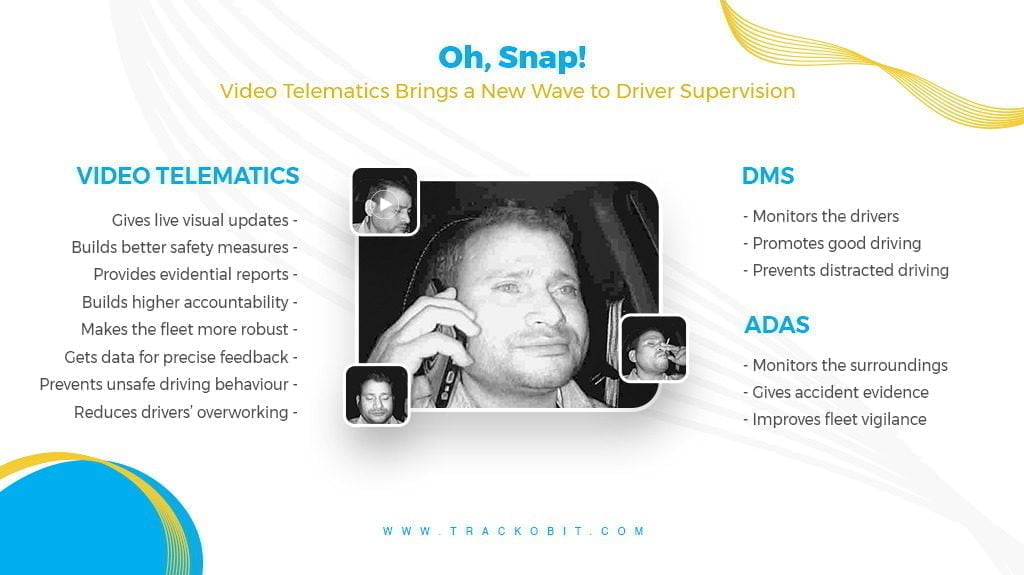
The Benefits of Tracking Driving Behaviour in Your Fleet
Drivers and vehicles are the two most important components of your fleet’s operations. And driver behaviour supervision bridges the gap between the two by helping managers understand how they function together. Here are a couple of other benefits of tracking driver behaviour in your fleet through vehicle tracking software:
Improvement in Asset and Business Safety
Be it safety for the vehicles, drivers, consignment, or business profits, a single feature protects them all! How? Let’s see:
- Safety for Consignment: Vehicles carrying fragile consignment need to be driven with extra carefulness. Driver scorecards allow you to understand which employees might be best for such smooth driving. It can also help managers keep a special check on drivers responsible for such vehicles to minimize consignment damage.
- Safety for Vehicles: If drivers practice safe skills, vehicles will automatically be safeguarded. Better driving supervision leads to lower damage to the vehicle’s parts, fewer collisions and accidents, and better vehicle maintenance.
- Safety for Drivers: Better driving practices lead to higher safety for drivers too. Moreover, they can steer clear of false claims of accidents through complete supervision systems. Drowsy drivers also reduce the risk of falling asleep through DMS alarms.
- Safety for Business: Better driver supervision saves business profits because it builds higher goodwill in the market while also protecting assets. It also reduces insurance claims hassles and many more fines and can reduce pilferage by monitoring fuel tank ejection or using commercial vehicles for personal use.
Increased Productivity and Fleet Strategy
Automating several processes such as knowing where drivers are and what is done inside a vehicle saves managers a lot of time. They can then spend this time on planning and strategizing their next step to improve profits. Managers get real-time updates about a driver’s productivity through the software.
When drivers too know that their number of tasks are being supervised, they are more likely to be more productive.
Better Employee Retention and Training
Good drivers are hard to find, and it is even harder to keep them if you do not treat them up to the mark. However, it is not easy for managers to know which drivers are the most dedicated and profitable for their fleet. It is these drivers that they need to retain and the others that they need to train.
Moreover, saving from false malpractices and appreciating or reward for all good practices is a splendid way to keep drivers in the fleet.
Longer Lasting Fleets
As mentioned earlier, good drive behaviour monitoring improves vehicle safety and health. Therefore, they will naturally stay in use for much longer than a fleet that is not well maintained. Moreover, driver supervision allows the vehicles to last much longer by making sure that everything inside the vehicle and the cabin is well maintained.
Better Fleet Reputation
Since drivers run vehicles and hence, most of your fleet’s operations, how they perform has a direct impact on your fleet’s reputation. And we all know how important is it for clients to trust and like your business to maintain your brand in the market.
Here are some ways in which improved driver performance increases your fleet’s goodwill:
- Even the most fragile consignment will reach your customers safely
- All deliveries will be conducted on time
- Your drivers will maintain safe behaviour on the roads
- The vehicles are well maintained and compliant, eventually making your name will clean business
At the end of the day, happy clients are the best advocates and influencers fo your business. And you can make sure that your drivers make them happy with effective supervision.
Better Coping With Increasing Fuel Prices
Increasing fuel prices is a huge global issue and the hassle is only going to increase in the coming years. As it is, fuel is the biggest expense in a fleet. Therefore, reducing field consumption with eco-driving practices enforced by supervising drivers is important.
Managers can check driving performances for an overall view. They can also check for real-time fuel consumption hazards such as overspeeding and idling to avoid wasteful fuel consumption.
Increased Fleet Profitability
Obviously, when vehicles consume less fuel and maintenance costs reduce because drivers work properly, overall operational costs will fall drastically. Moreover, increase goodwill and better handling of products will lead to more profits.
When both these solutions amalgamate in a large fleet, you can rest assured that your business profits are only set to skyrocket!
How Driver Monitoring Systems Help Drivers Too
Drivers often resist adopting fleet management systems. Why? Because they feel that they will be constantly under surveillance and feel that their privacy is in danger.
While drivers are not wrong in believing that they will be under a strict check, they are generally not aware of the benefits driver behaviour management systems have for them. These systems increase driver safety, both physically, and mentally. Here’s now:
- Ensure Safety: Drowsy driver alarms will wake them up if they are falling asleep, and any collision possibility will be put into their radar as well. Moreover, with a comprehensive fleet management system, they also get SOS buttons to ask for help from managers whenever they seem to be in trouble.
- Better Career: With driver behaviour monitoring systems, drivers get directed and detailed feedback considering that their individual performance is tracked. Moreover, if they maintain a good driver score, they can use it as an achievement to flaunt while getting a new job.
- Excess Driving: The system keeps tabs on the number of hours a vehicle is driven and which driver has been active on it. This way, In case a driver has been working much more than healthy, they will be notified to take some rest for their mind and body. This way, they can always stay fresh while driving, keeping them safer.
- No False Blame: When a commercial truck is involved in an accident, it is usually the truck driver who is set to blame. However, they are obviously not always in the wrong, and that can be proved through evidence from video telematics. Therefore, drivers will never be falsely blamed again.
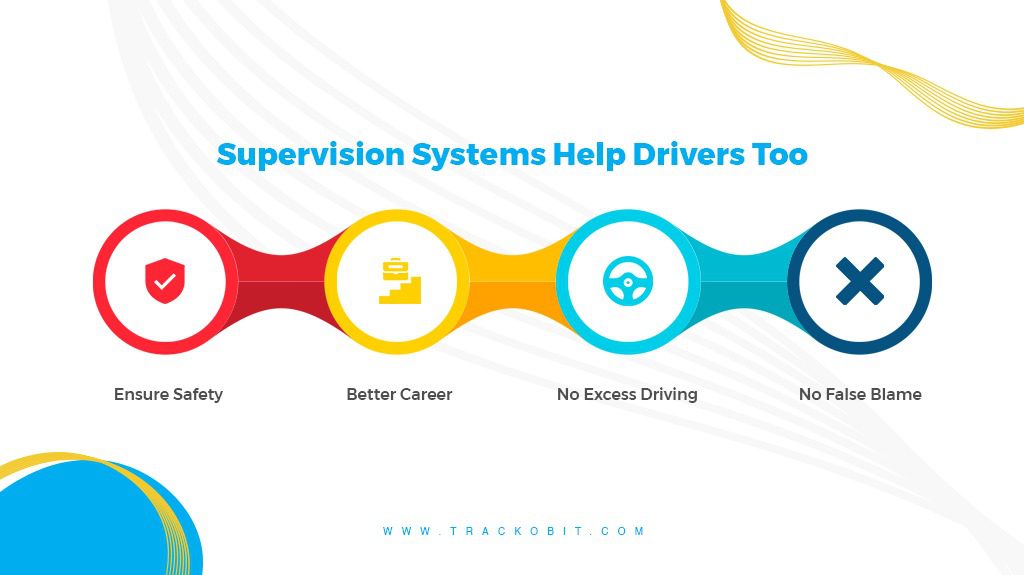
Some Fleet Problems TrackoBit Solved With Driver Behaviour Management Solutions
Driver behaviour management solutions are not just restricted to supervising drivers and checking what they are up to in the fleet. Instead, when paired with the features of fleet management software, they can solve several problems in the fleet.
We talked to some of our clients and figure out how to solve some of their leading problems subtly with driver behaviour management solutions. Let’s look into them below!
Problem 1: My Vehicles Are Consuming Too Much Fuel
We understood that there are several reasons why a fleet might be consuming too much fuel. So, we first run complete vehicle diagnostics for the fleet and then optimised all their routes. However, the vehicles still had poor mileage and the fleet continued to consume too much fuel. Therefore, we used driver monitoring solutions to understand why that way and found that:
- Drivers were idling too much
- Overspeeding was a recurrent issue
To solve these problems, we recommended the client to religiously check idling reports on the software and enabled both overspeeding and idling alarms. By doing so, the managers got real-time updates on when drivers were indulging in field-wasting driving patterns and hence, could train them better.
Resultingly, our client was able to significantly cut down on fuel consumption and were also able to reduce the instances of accidents on highways.
Problem 2: My Fleet Business Received Low Insurance Claims
One of our clients was confused as to why their fleet business got low insurance claims even though they had fewer instances of accidents on the highway than most of their competitors. After running a complete analysis of the fleet, we realised that the problem was with the fact that the client did not use driver behaviour management systems. Because of this, the insurance company could blame anything on the drivers.
So, we recommended the client install dashcams in their vehicles and integrated them with our system. We also started collecting all driver behaviour data and presented digestible reports to the clients to understand and present further.
By doing so, the client was able to show the insurance company how reliable and safe their drivers and fleet are. With this, they were able to build a solid case and get their insurance claims back on track and absolve their drivers of any false blame.
The Best Way to Drive Your Fleet…
We’re sure you knew that drivers were important, but didn’t expect to realise how much they influence your fleet operations. To run a successful fleet business, you need to identify, nurture, and retain the good drivers while identifying, supervising, and training the bad ones. And this distinction is only possible to make through the driver data collected on software.
This software can be TrackoBit, India’s fastest-growing telematics software. With our superior driver behaviour managing system, we were able to access most of your problems on solving them for you!
TrackoBit able to access most of your problems on solving them for you!
Driver Behaviour Monitoring FAQs
-
Can driver behaviour monitoring solutions improve fleet safety?
Yes! Driver behaviour monitoring is a critical feature helping increase overall fleet safety. With smart driver supervision, fleet managers can manage to improve safety for all assets and the overall business. When drivers follow safe practices, they automatically safeguard themselves, the vehicle, and the consignment. And by doing so, they are able to maintain safety for the business’ profits and goodwill. For special safety measures of special routes and consignments, managers can increase the supervision level on the trip as well!
-
How does driver monitoring work?
For driver monitoring systems to function, the vehicles must first be connected to efficient fleet management software. Through various hardware and the vehicles’ ODM readings, the software can then start collecting data on how the drivers are treating their vehicles. For example, every instance of harsh braking would be registered on the software under the driver’s profile. This way, each drivers’ strengths and weaknesses are recorded and presented to managers in a simple format. For live driver monitoring solutions, the system can also send alerts to the drivers as and when they indulge in risky or prohibited behaviour. Managers can check reports not only driver-wise but also vehicle and trip-wise to understand driving patterns and behaviour from a more comprehensive lens.
-
How can driver scorecards improve fleet performance?
Driver scorecard is an evaluation of various driving aspects. This includes speeding, route adherence, harsh braking, safety and compliance, and fuel efficiency. The scorecard primarily improves overall fleet performance by helping managers with risk assessment, that is, detecting unsafe driving patterns. Other ways it improves fleet management are by helping with:
- Identifying scope of training
- Route planning and optimization
- Allotting the right wages to good drivers
- Ensuring eco-friendly driving practices
- Ranking drivers (efficient or underperforming)
The best fleet management software also allows gamification of scorecards! With rules, rewards, and incentives, drivers are encouraged to driver safe and reduce expenses.
-
Can you achieve prediction of dangerous driver behaviour with fleet management software?
Oh yes, totally! Modern fleet management solutions improve driver supervision with the help of video telematics systems. These systems include DMS and Adas, which are essentially AI-powered supervision tools helping managers get a predictive understanding of what is going to happen to their fleet. DMS and ADAS together can predict side, back, or forward collisions. Moreover, they can also predict any danger when drivers are distracted or sleepy. Other than video telematics solutions, driver behaviour supervision can also help understand what routes tend to be more dangerous for which drivers and which drivers can be the be ideal for fragile consignment, etc.
-
What are some effects of bad driving behaviour on the fleet?
Drivers are responsible for some of the most important functions in your fleet. Therefore, if they go wrong somewhere, their mistakes can lead to: 1. Loss in goodwill 2. Quickly depreciating assets 3. Frequent accidents 4. Resource wastage 5. Bad relations with customers 6. Increase insurance troubles 7. Lower the bottom line of your business
-
How do companies ensure driver privacy while monitoring behaviour?
Companies can leverage a driver behaviour monitoring tracking software that promises supervision and not spying! The drivers will know that they are being supervised, and their data is being collected. Nothing is hidden or used without their knowledge which protects their privacy. It also encourages safer driving habits and a transparent work culture for them.
Ayushi Nagalia is a Senior Content Specialist at TrackoBit. She is a marketing maverick with a lush background in literature. With years of experience crafting content for various niches, she speciali... Read More
Related Blogs
-

When Tracking Needs a Clock: Rethinking Fleet Visibility
Tithi Agarwal December 24, 2025Read on to understand why fleet tracking works better when it follows working hours. Because visibility should support operations, not…
-

What Makes TrackoBit’s Video Telematics Software Truly Next-Gen?
Shemanti Ghosh December 17, 2025TrackoBit’s video telematics software blends smart video intelligence with full server control. The result? Superior fleet reliability and safety.
-

Plug, Pair, Perform TrackoBit Introduces BLE Sensor Integration
Tithi Agarwal November 26, 2025TrackoBit’s BLE Sensor Integration enables wireless, real-time monitoring with faster installs and accurate insights. It improves fleet efficiency, visibility, and…
-

How to Use Driver Behavior Reports as a Sales Hook to Close Big Fleets
Tithi Agarwal October 16, 2025TrackoBit’s driver behavior reports empower fleet providers to win big contracts by showcasing safety, efficiency, and measurable ROI.

Subscribe for weekly tips to optimize your fleet’s potential!
Your inbox awaits a welcome email. Stay tuned for the latest blog updates & expert insights.
"While you're here, dive into some more reads or grab quick bites from our social platforms!"Stay Updated on tech, telematics and mobility. Don't miss out on the latest in the industry.
We use cookies to enhance and personalize your browsing experience. By continuing to use our website, you agree to our Privacy Policy.

































